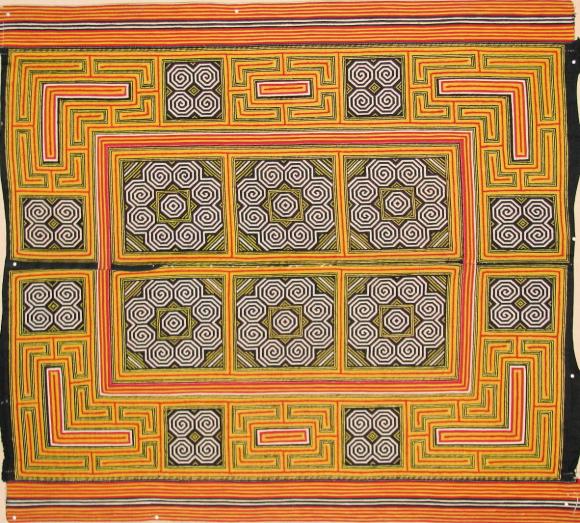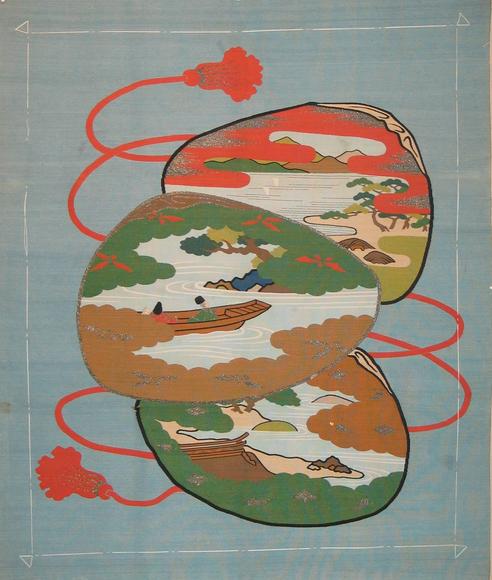Last month we had the privilege of visiting Kathleen Taylor’s Lotus Collection in Sausalito, CA. The Lotus collection has been a tremendous source of antique decorative textiles for decades, and we were thrilled to meet with Kathleen, tour the space, and see some of these incredible pieces up close. Some of our favorites: an 18th century piece embroidered with beetle wings, a turn of the century Japanese wall-hanging dyed with rich natural indigo, and intricate yellow, red and green c. 1930 Chinese cotton embroidery pieces. Kathleen was generous enough to spend some time with us and to share her insights and experiences in the study and collection of textiles.

Circa 1930 China (Miao Minority) shoulder cover. Embroidery, appliqué and cross stitch. Courtesy of Kathleen Taylor-The Lotus Collection
How did you become interested in working with antique textiles?
I had gone back to college to finish my under grad work and go to law school. Instead I became an Art History major and graduated with a BA in Art History. I have never looked back. However, I needed to figure out how I could work in the decorative arts. A friend of mine had a business selling antique Chinese & Japanese textiles plus costume. We started discussing his business and came to the decision I would join him. Mills College has a really good Art History department and I had a lot of course study of both Chinese & Japanese art. I was fairly well prepared to research the variety of textiles we came to discover. I learned quickly how much you could understand about a society by the textiles they produced and the clothing they wore. Italian textiles had been of tremendous interest while I was an under grad, particularly the velvets produced in Venice and Genoa, but I came to love Chinese and Japanese textiles as much. Today I still have some Chinese textiles but more Japanese. Of course I still keep a good inventory of English, French, Italian, Middle Eastern & African textiles.

What is currently your favorite textile in The Lotus Collection?
Always a difficult question to answer! I recently acquired an early 18th century Italian silk & metallic embroidery depicting scrolling vines and flower heads with a central nude woman chained to a tree. The embroidery is exquisite and the nude chained to a tree has initiated a lot of discussion. It is probably a part of valences to bed hangings possibly given as a wedding gift. Another recent acquisition is a beautiful yellow silk satin table cover, embroidered with flowers, scrolls, and bird heads. This is a c.1830 Chinese export table cover made in Macao for the Portuguese (European) Market.
What is a recent discovery in the world of textiles that has interested you?
The ongoing discoveries of ancient tombs in China continue to reveal the sophistication of Chinese textiles.
Which piece in your collection do you think has the most fascinating backstory?
If textiles could talk! Sometime we know the provenance of a textile because it has inventory marks and even a family name sewn or attached. For the most part it is anyone’s best guess. However, many of our textiles were made to be used domestically or used for clothing. Often textiles come with wonderful mending stitches that allowed the textile to be remade. Recycling textiles into other purpose is an age old practice because textiles were expensive and highly valued. Often the textiles used in room decoration were more expensive than the furniture in the room.
Probably for me the most interesting back stories are of the oldest textiles I have ever handled and how they came to me. Two in particular, one Chinese and one Italian, were presented by private parties, one in a potato chip bag and another in a pharmacy plastic bag. Different sources, but both of these textiles were wadded up and dirty. You have to have experience and a good eye to understand what you are looking at! The Italian textile was 16th century and the Chinese textile was early Ming Dynasty (1368-1644.) Very exciting!

An 18th century textile embroidered with beetle wings
What is your favorite hidden gem in Sausalito?
At the end of Harbor Drive there is a wonderful dog park where I take my dog, Molly, late in the afternoon. It is a spit of land that sticks out into the bay between boat docks. There you can see lots of birds, sea lions, a great view of San Francisco and also Mt. Tam. The sunsets are amazing. Of course right next door is the restaurant, Fish – certainly hidden, but well known to many.

Kathleen Taylor in her showroom
Visit ktaylor-lotus.com for more information on Kathleen and her illustrious collection.
